The Radio-Rem Emanator (ca. 1920)
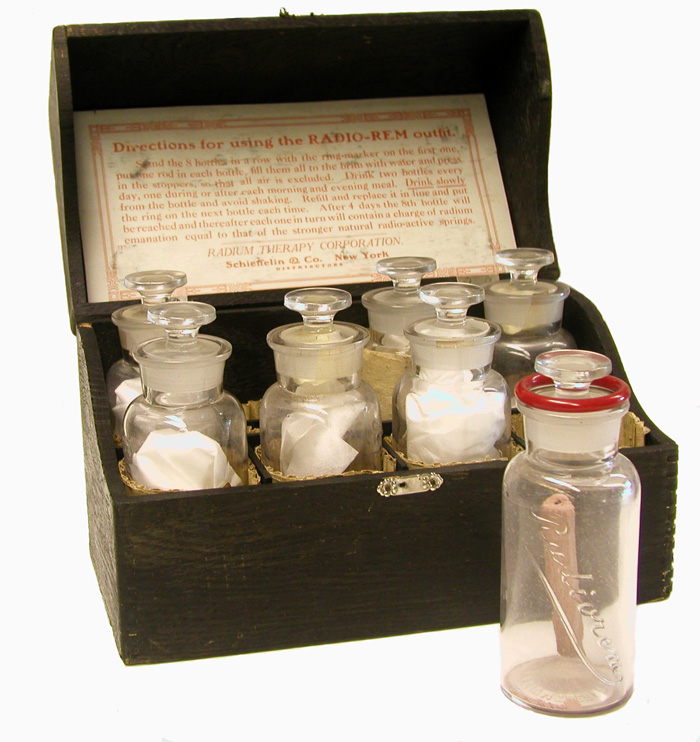
The Radio-Rem (as in "radioactive-remedy") was manufactured by Schiefflin and Company of New York, a well-known pharmaceutical company.
The eight bottle version featured here was known as the Radio-Rem C. It was the least expensive version ($15) as well as the weakest.
All eight bottles were filled with water and left to charge over a four day period. Inside each bottle was a radium-containing brownish-pink terra cotta rod which released radon into the water. According to the manufacturer's literature, the radium was in the form of radium sulphate.
After four days, one bottle would be consumed in the morning and a second bottle consumed in the afternoon. After drinking the water, the bottles were refilled and allowed to recharge. By the time the water in the eighth bottle had been consumed, the water in the first bottle would have had the necessary four days to recharge. A red plastic ring was used to keep track of which bottle was to be drunk next.
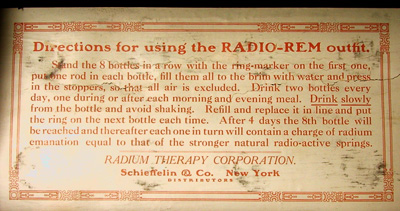
Size: The individual bottles are ca. 6 1/2" high and 2 1/2" in diameter
Exposure rate: ca. 12 uR/hr above background at 1 foot from single bottle
According to the manufacturer's literature describing the Radio-Rem C,
"the strength of the charge may be easily controlled. Each rod will yield 100 Mache units... Inasmuch as water charged with emanation by means of one RADIO-REM rod in the manner previously described contains 100 Mache units, each daily dose (two bottles) supplies 200 Mache units, an amount comparing favorably with that furnished by the stronger radio-active springs."
There were four different, two-bottle outfits:
- No.2 yielding 1000 Mache units - $25
- No.3 yielding 2000 Mache units - $45
- No.4 yielding 5000 Mache units - $90
- No.5 yielding 10,000 Mache units - $150
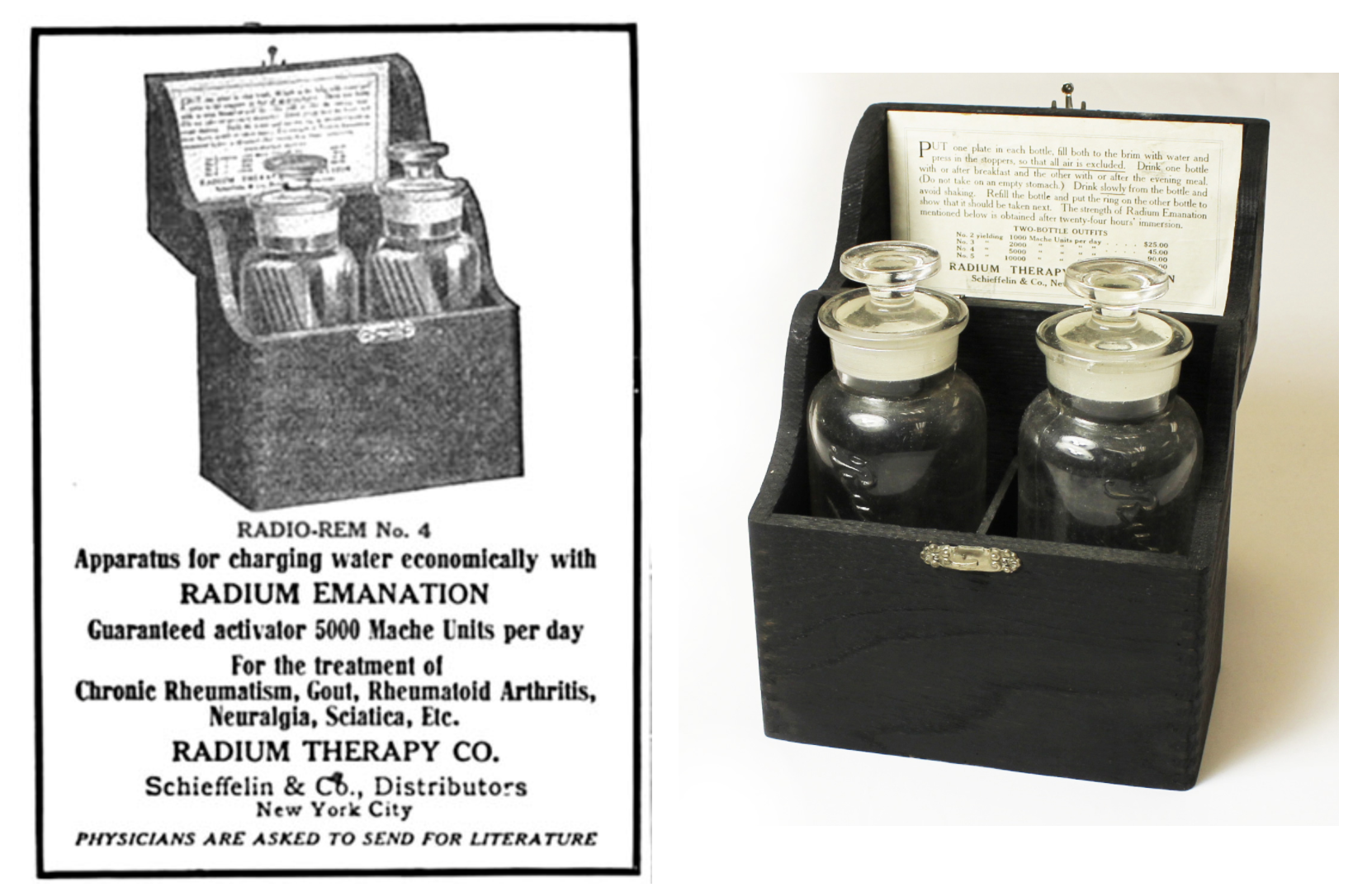
The example in the ORAU collection, a No. 4, is pictured above right. Above left is an advertisement for one that appeared in JAMA in 1916 (Vol. 67 (13) Sept. 23, 1916).
In 1914, when the Radio-Rem outfits first became available, there were three versions. The basic eight bottle Radium-Rem would later be known as the Radio-Rem C. Based on the pricing, I suspect that the other two, the Radio-Rem M and the Radio-Rem X, would become Outfits No. 2, and No. 4, respectively.
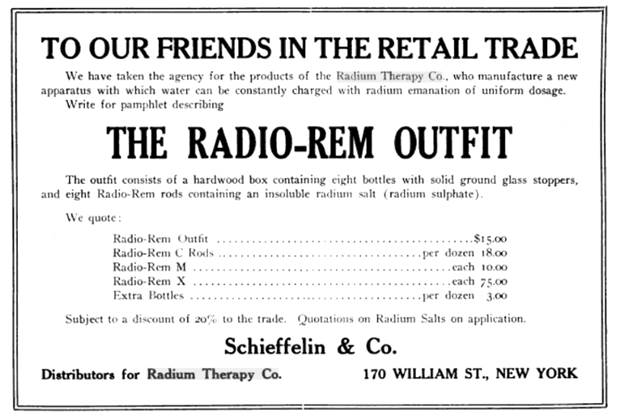
The above ad is from the December 1914 issue of the American Druggist (Vol. 62, 1914).
Approval from the American Medical Association
To be approved by the American Medical Association (AMA), a radium emanator had to be reviewed by their Council on Pharmacy and Chemistry. The following quotes are from the Council’s report on the Radio-Rem outfits (JAMA Aug. 19, 1916).
“Those who are well informed on the subject of radium therapy are of the opinion that the administration of small amounts of radium emanation... is without value... In consideration of these facts The Council voted not to accept any radium emanation generator which produces less than 2 microcuries of emanation during twenty-four hours. Accordingly, while accepting Radio-Rem Outfit No. 5, claimed to produce 10,000 Mache units (3.7 microcuries) and Radio-Rem Outfit No. 4, claimed to produce 5,000 Mache units (1,8 microcuries), the Council voted not to accept Radio-rem Outfit No. 3, claimed to produce 2,000 Mache units (0.74 microcurie), Radio-Rem Outfit No. 2, claimed to produce 1,000 Mache units (0.37 microcurie), and Radio-Rem Outfit C, claimed to produce 200 Mache units (0.07 microcurie).”
“Each of the above-described radio-rem outfits [Outfits No. 4 and No. 5] consists of two glass stoppered bottles of about 250 cc capacity, each containing a fired, porous clay (terra cotta) plate, said to contain radium sulphate... A test made for the Council demonstrated that during the impregnation of the water with radium emanation, no radium is dissolved in the water” (New and Nonofficial Remedies. AMA. 1922).
Radium Therapy Corporation
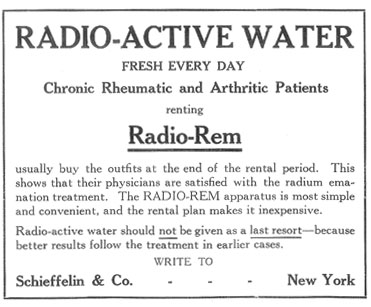
The company was incorporated May 7, 1914 with the stated purpose of manufacturing and dealing in minerals and their products. As best as I can determine, their sole purpose was the production of Radio-Rem outfits—statements of purpose made during incorporation tend to be overly general.
The capitalization was indicated to be $1,500,000. Three directors were identified in the articles of incorporation: William J. Schieffelin, Schuyler Schieffelin and William Osgood Field.
By 1919, the company management consistent of (R. L. Polk & Co.'s Troy New York Copartnership and Corporation Directory. 1919):
William J. Schieffelin, President
William Osgood Field, Vice-President
Rudolf E. F. Flinsch, Secretary
Schuyler Schieffelin , treasurer
Ernesto J. Fabbri, Board of Directors
Curt Schmidt, Board of Directors
David Hennen Morris, Board of Directors
For me the name that jumps out of that list is Curt Schmidt. Yes, that Curt Schmidt.
Radium Therapy Corporation was a subsidiary of Schieffelin & Company, the New York pharmaceutical powerhouse. Both companies were controlled by the same people, William and Scuyler Schieffelin, and they shared the same address, 170 William Street, New York, NY. Radium Therapy Corporation produced the Radio-Rem outfits while Schieffelin & Company handled distribution and marketing.
Shieffelin & Company
Shieffelin & Co. marketed and distributed the Radio-Rem outfits for the Radium Therapy Corporation.
The company was founded in the eighteenth century by a German immigrant as a wholesale drug distributor, and that’s essentially what it was when the Radio-Rem was produced. Today, they are an importer and distributor of wines and spirits.
William Jay Schieffelin
In the days of the Radio-Rem, the company president was William Jay Schieffelin, a remarkable individual. It is worth looking him up on the web. The following barely scratches the surface.
Schieffelin was a very rich and very religious Republican who had a Ph.B. from the Columbia School of Mines (phi beta kappa) and a Ph.D. (honors) in chemistry from Munich.
In 1918 alone, he was the president of eight companies: Schieffelin & Company, American Church Missionary Society, American Kitchen Products Co., Druggist’s Supply Corp., General Steel Treating Corp., Mandingo Development Corp., Radium Therapy Corp., and U.S. Chicle Refining Co., (Directory of Directors in the City of New York. 1918).
His commitment to civil rights was particularly impressive. A few examples: during WWI, Shieffelin was in charge of a “colored” unit known as the “Harlem Hellfighters” (forced to coordinate with the French forces rather than the Americans); he worked closely with Booker T. Robinson to obtain funding for black educational institutions; he served as chairman of the board of the Tuskegee Institute; and was the chairman of the defense committee for the “Scottsboro Boys.” Unrelated to civil rights, but interesting to note, he helped overthrow the corrupt Walker administration in New York City.
Why he decided to incorporate radium into the company’s product line is not clear. Perhaps the decision resulted in part from the publicity surrounding Pittsburgh’s Standard Chemical Company. The latter was founded in 1911 by Joseph Flannery for the purpose of supplying radium to the medical profession—a worthy endeavor that Schieffelin could relate to.
Schuyler Shieffelin
Schuyler Shieffelin (William’s cousin ?) was treasurer of the Radium Therapy Corporation. He was also a director of the Federal Terra Cotta Company. The possible relevance of this is that the Radio-Rem outfits employed radium-containing terra cotta plates as the source of radium emanation (radon).
William Osgood Field
Field was the Vice-President of the Radium Therapy Corporation. He probably got the job because he moved in the same civic and philanthropic circles as William Shieffelin. In addition, they were both related to the Vanderbilts, Field by marriage and Schieffelin by blood.
Curt Schmidt
Curt Schmidt was on the Board of Directors of the Radium Therapy Company, a position he owed to two patents: 1,032,779 and 1,032,951. Both of these were issued July 16, 1912, the date prominently stenciled on the front of the original version of the Revigator, and both had the same title, Radio-Active Material. The second patent (1,032,951) can be considered a brief addendum to the first (1,032,779).
Quoting Schmidt’s introduction to these patents:
“Be it known that I, CURT SCHMIDT, a subject of the German Emperor, works director of Alum Works, near Freienwalde on-the-Oder, Germany, have invented certain new and useful Improvements in Radio-Active Materials... The invention relates to a radio-active material, and is designed to render other solid bodies, gases or liquids radio-active by emanation.”
To be specific, his patents pertained to the manufacture of a radioactive material or device that was suitable for infusing another material (typically water) with radon. In the case of the Radio-Rem, the patent related to the grooved terra cotta plate (or bar) that goes in each glass bottle.
It is possible that Schmidt came to New York at the invitation of Schieffelin in order to set up the production facility for the plates. Perhaps Schieffelin contacted Schmidt through business contacts in Germany, or maybe the two men knew each other—Schieffelin obtained his doctoral degree in Munich.
How long Schmidt stayed with Schieffelin & Company, I don’t know. That he might have moved out of NYC by 1919 is suggested by several newspaper notices (e.g., The Sun. Sept. 16, 1919) indicating that the New York Trust Company was holding unclaimed funds that belonged to him.
Otto Paul Curt Bredt
Bredt’s involvement with the Radium Therapy Corporation is a bit of a mystery, but two of his patents provide a clue: “Production of Concentrated Radium Residues and the Separation of Radium Compounds Therefrom” (1,154,230) and “Process for Concentrating Radium Ores and Residues” (1,154,231). The latter patent was assigned, in part, to the Radium Therapy Company. Both patents identify Bredt as a German citizen residing at 170 William Street in New York, the Schieffelin & Co. headquarters. The implication is that Schieffelin was considering the possibility of obtaining purified radium (or a concentrate) directly from ore.
Donated by John Wilson.
References
- Radium Therapy Corporation. Radium Emanation Therapy with Radio-Rem. Brochure. No date, but references up to 1914.
- Radium Therapy Co. Radio-Rem. Brochure. No date.
- American Medical Association. New and Nonofficial Remedies, 1922.
G.A. Roush (ed.). The Mineral Industry. Its Statistics, technology and Trade During 1914. McGraw-Hill. 1915.
